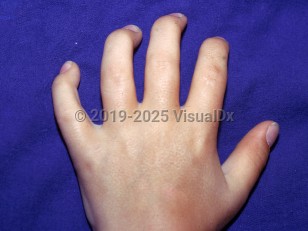Scheie syndrome in Child
Alerts and Notices
Important News & Links
Synopsis

A rare genetic metabolic disease where the body improperly breaks down glycosaminoglycans. It belongs to the group of diseases called mucopolysaccharidoses (MPS). It is considered the mildest form of MPS type I (MPS I). MPS I is caused by a recessively inherited defect in the lysosomal alpha-L-iduronidase enzyme, which is essential to the development of connective tissues. Scheie syndrome is characterized by clawing of the hands, corneal clouding, incompetence of the aortic valve of the heart, and carpal tunnel syndrome. Symptoms usually occur after age 5 but are typically so mild that the diagnosis is not apparent until adulthood. Patients are of normal height and intelligence.
Scheie syndrome is caused by mutations in the IDUA gene. Ocular manifestations of the disease include corneal opacification that occurs progressively and diffusely (usually after age 4) and glaucoma. Patients may also present with coarsening of the facial features, such as a large mouth and thickening of lips. Some patients may present with nasal discharge, sensorineural hearing loss, joint stiffness, minor skeletal changes, and carpal tunnel syndrome. In certain cases, aortic valve disease may be present. Compression of the cervical spinal cord may lead to spastic paresis if not corrected by early neurosurgical intervention.
Treatment requires a multidisciplinary team and, if carried out early, should slow the progression of disease. Enzyme replacement therapy is suggested upon confirmation of diagnosis and may benefit patients waiting for hematopoietic stem cell transplantation. Life expectancy of Scheie syndrome patients is only slightly affected.
Scheie syndrome is caused by mutations in the IDUA gene. Ocular manifestations of the disease include corneal opacification that occurs progressively and diffusely (usually after age 4) and glaucoma. Patients may also present with coarsening of the facial features, such as a large mouth and thickening of lips. Some patients may present with nasal discharge, sensorineural hearing loss, joint stiffness, minor skeletal changes, and carpal tunnel syndrome. In certain cases, aortic valve disease may be present. Compression of the cervical spinal cord may lead to spastic paresis if not corrected by early neurosurgical intervention.
Treatment requires a multidisciplinary team and, if carried out early, should slow the progression of disease. Enzyme replacement therapy is suggested upon confirmation of diagnosis and may benefit patients waiting for hematopoietic stem cell transplantation. Life expectancy of Scheie syndrome patients is only slightly affected.
Codes
ICD10CM:
E76.03 – Scheie's syndrome
SNOMEDCT:
73123008 – Mucopolysaccharidosis type I-S
E76.03 – Scheie's syndrome
SNOMEDCT:
73123008 – Mucopolysaccharidosis type I-S
Best Tests
Subscription Required
References
Subscription Required
Last Updated:01/23/2022
Scheie syndrome in Child

